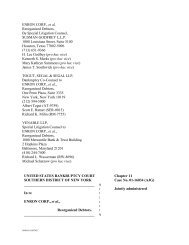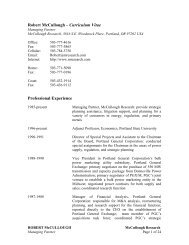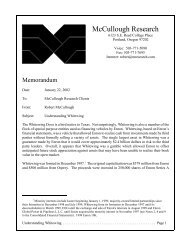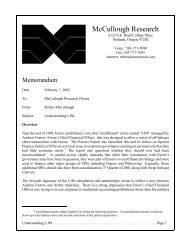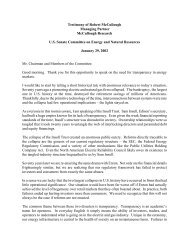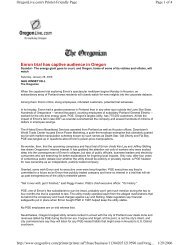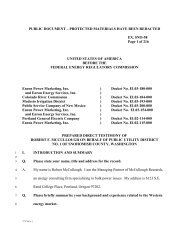Congestion Manipulation - McCullough Research
Congestion Manipulation - McCullough Research
Congestion Manipulation - McCullough Research
Create successful ePaper yourself
Turn your PDF publications into a flip-book with our unique Google optimized e-Paper software.
Each of these schemes is a subset of the generic scheme, Deathstar, where an imaginary schedule is<br />
filed with the ISO that elicits payments for the alleviation of congestion. Since the ISO is rules-based<br />
rather than results-based, no actual generation is required for the right to file schedules. The only<br />
issues within the ISO pertain to whether the schedules met the rules – even if they failed to meet any<br />
engineering logic.<br />
Each scheme is based on the fact that schedules can be broken before energy flows take place. This<br />
allowed Enron to create an imaginary cycle of trades through the ISO. A common form of financial<br />
fraud is known as “check kiting.” In this fraud, a con man writes checks between a cycle of bank<br />
accounts. The frequent deposits and withdrawals lull the bank into believing that real transactions<br />
are taking place. Eventually, the con man withdraws all the deposits at once, leaving the bank to<br />
discover that recently deposited checks will bounce since the accounts they were written on have been<br />
closed.<br />
In this case, Enron knew that the ISO would trigger the adjustment bids and cancel the proposed<br />
transaction. Even if the transaction wasn’t ended by the ISO, the schemes had enough counterparties<br />
that the ISO would not know that no energy actually flowed.<br />
It is critical to understand that if Enron, or any market player, can alleviate congestion south to north,<br />
they can cause congestion to occur with identical methods simply by reversing the direction of the<br />
imaginary schedules. The ability to cause – or alleviate – congestion allows a form of arbitrage where<br />
it is possible to cause the ISO to declare an emergency because congestion blocks access to loads<br />
when the incentives are right.<br />
Schedules and Flows<br />
While most customers of electric utilities (and not a few policy makers) believe that electricity is like<br />
natural gas – a commodity that can be transported and stored by the direction of the utilities – the<br />
reality is much different. Electricity moves at the speed of light. We have little ability to direct the<br />
flows of electricity once it is generated. Our approach to this unique operating problem is to control<br />
the generation of electricity, and in a few rare cases, the consumption, in order to create a pattern of<br />
generation that induces the electric flows through the transmission system. In order to get electricity<br />
to flow south over the California Oregon Intertie, we increase generation above loads in Oregon and<br />
Washington and allow generation to fall below loads in California. Since this is vastly more complex<br />
than simply trucking products where they are needed, it is critical to plan the operation in advance.<br />
Industry practice has been to preschedule plant operations and transmission use. The schedules are<br />
constructed a week in advance. As the date of delivery approaches, the schedules are updated on a<br />
daily basis, and eventually on an hourly basis. During the hour of consumption, adjustments to make<br />
the schedules match reality – usually caused by changes in weather of equipment failure – are made<br />
by the system operators in “real time.”<br />
A central facet of the California ISO was the attempt to automate as much of this process as possible.<br />
Generators and consumers file schedules a day ahead. The ISO compares these schedules with<br />
transmission constraints and develops a feasible schedule of generation that matches the capacity of<br />
<strong>Congestion</strong> <strong>Manipulation</strong> in ISO California ......................................Page 5





